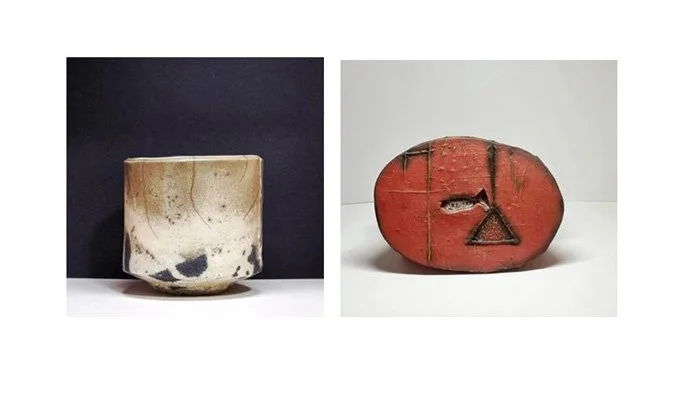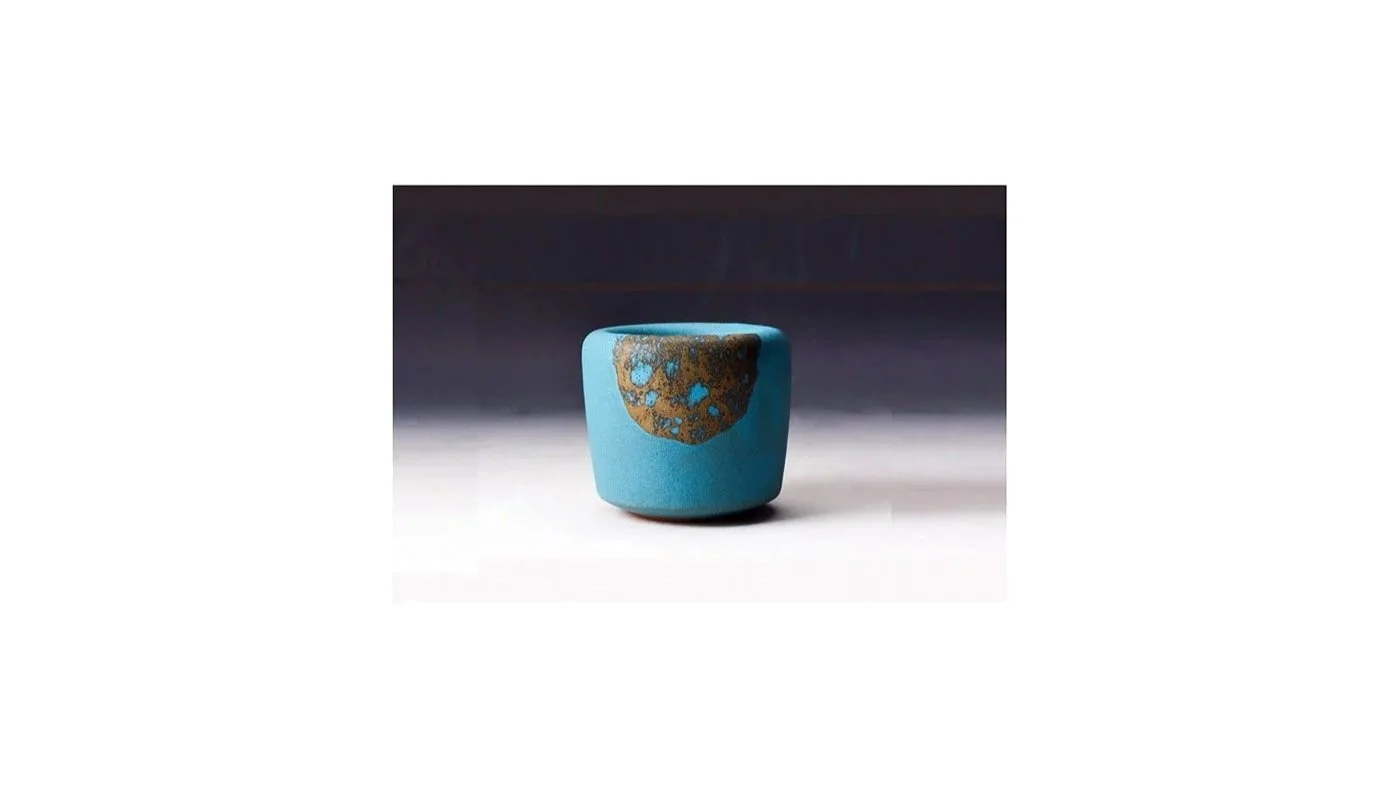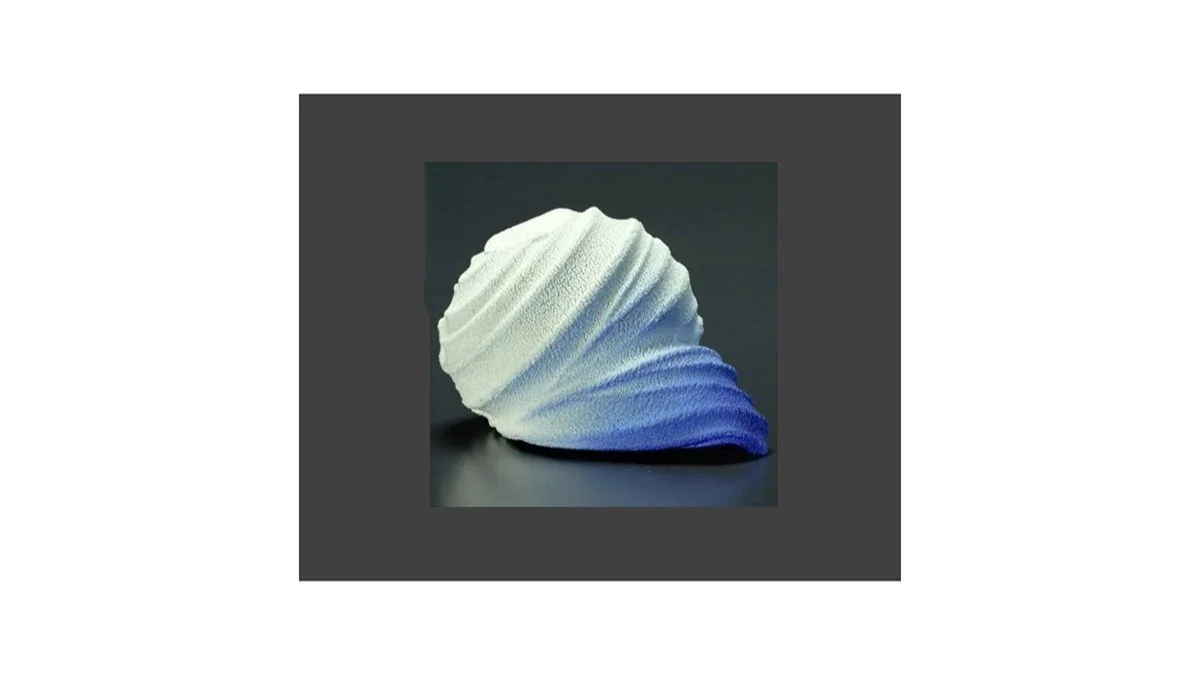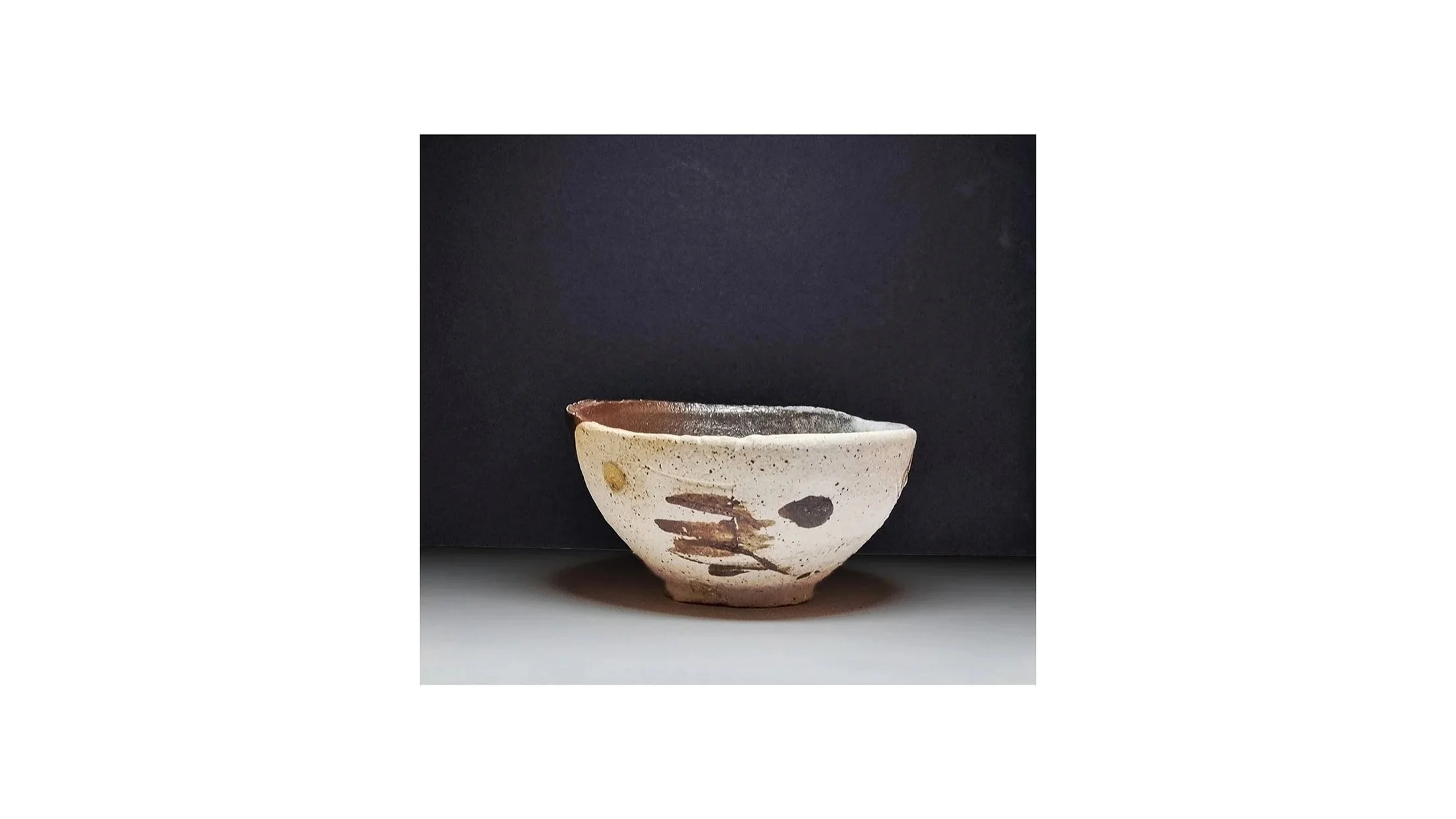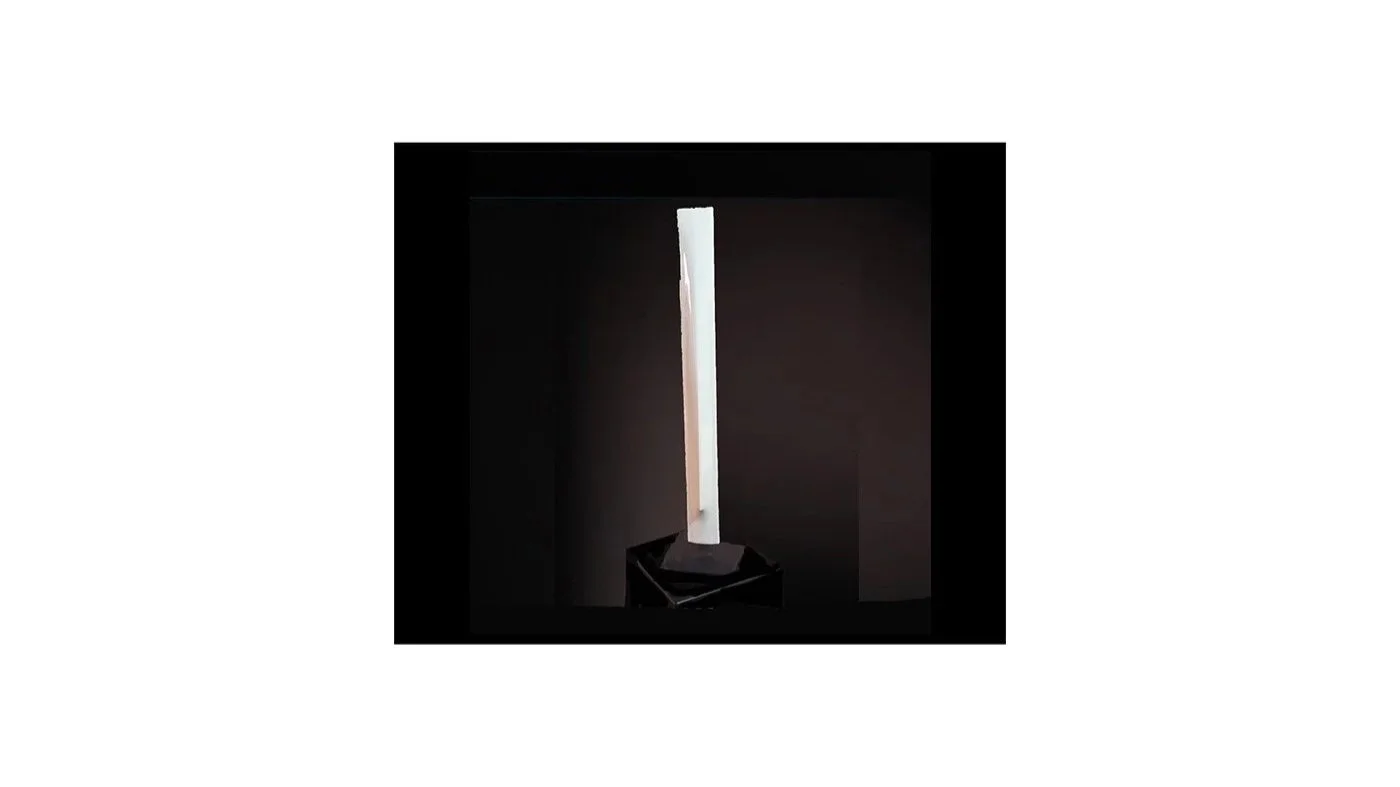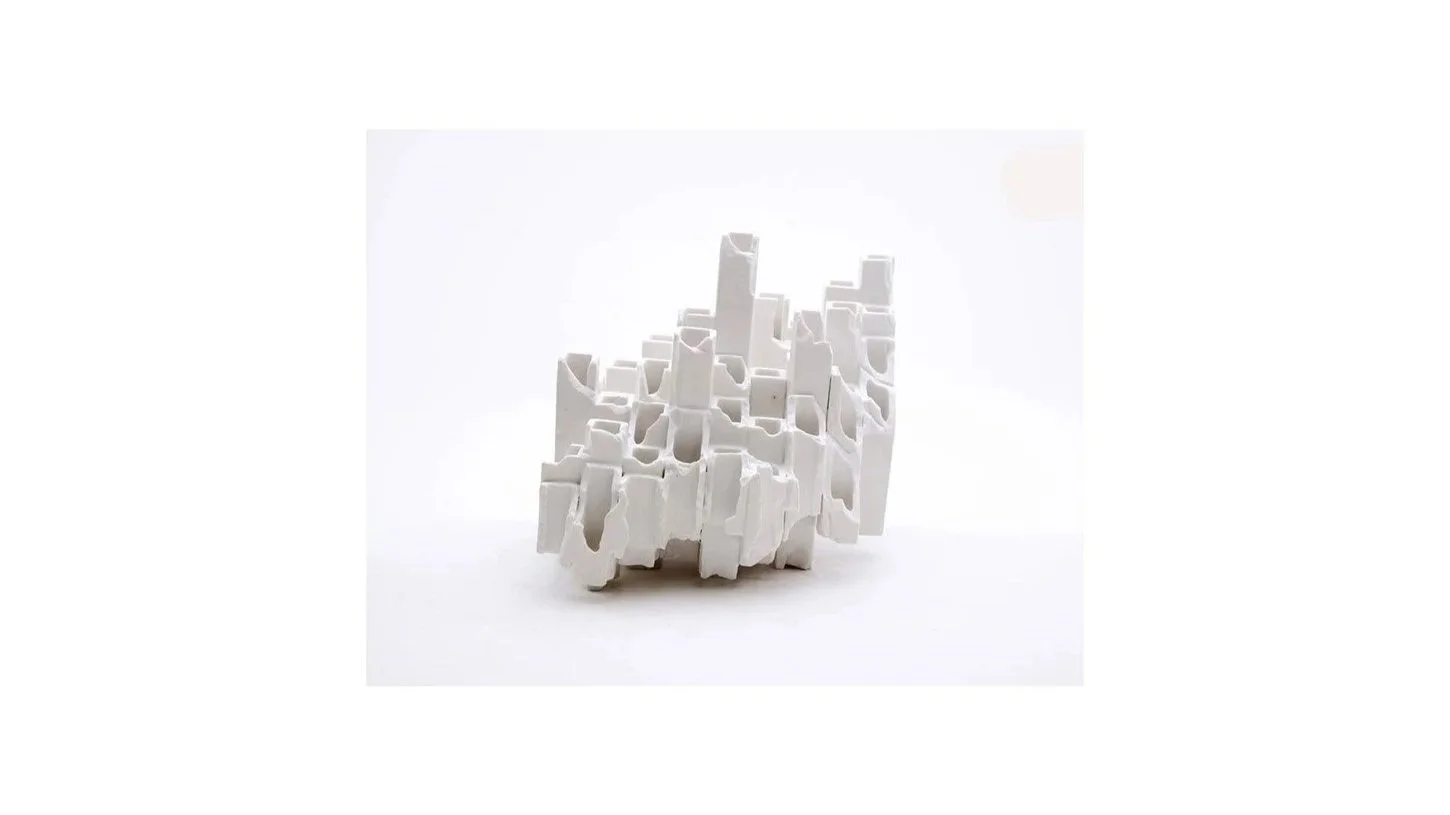CONTEMPORARY WORKS
Japan has been and continues to be a country of potters. New generations of potters are striving to make their art and their mark through innovative works that are rooted in tradition but not bound by it. This gallery showcases works by modern potters, including many young artists, that have transformed Japanese ceramics from a craft to a vibrant and expressive art form.
A simple but striking vase Yagi Kazou, who co-founded Sodeisha (“Crawling through the Mud”), the avant-garde movement which lasted from 1948 to 1998. Built without a wheel, the vase abstracts the traditional vase shape, which together with the quiet luster of the white glaze gives it an organic beauty that transcends its practical purpose. This work belongs to a series known as shiroi hensubo, an expression that could be translated as “deformed white vase,” which Yagi Kazuo developed in the 1970s as a study of materials and sculptural forms.
An abstract sculpture of a wild boar by Suzuki Osamu, co-founder of Sodeisha and a pioneer of non-functional ceramics emphasizing form and concept rather than utility. This sculpture is from his Zodiac series of the twelve animals of the East Asian zodiac, showcasing his whimsical approach to clay making, using abstraction as the leitmotif. The series features Seihakuji, a type of bluish-white porcelain with a celadon glaze, a technique Suzuki was inspired to use due to his long-standing admiration for Song Dynasty ware from China.
An architectural sculpture by the avant-garde pioneer, Kamakura Jenkichi who was a core member of Sodeisha. The sculpture is of cuboid form with cutout openings around the rim. The piece is raised on four double feet and the entire surface is covered in a matte rust-brown glaze.
Kamakura Junkichi was a major figure in the world of Japanese sculptural ceramics. He graduated in 1942 from Kyoto Institute of Technology as a design major. From 1946 to 1947, Kamakura, along with Tamura Kōichi (1918-1987), was an assistant to Tomimoto Kenkichi at Shōsai tōen kiln, where he was greatly influenced by the master’s techniques and his concept of the ceramist-artist. Not long after, he joined Sōdeisha, and created some of the most surreal ceramic works known at the time. His pieces are held by important museums, including the National Museums of Modern Art in Tokyo and Kyoto, the Shigaraki Ceramic Park Museum, Victoria & Albert Museum in London and the Newcastle Art Gallery in Australia.
A hand-built cube vase by an unknown artist in style of Suzuki Osamu (1926-2001). The vase embraces Suzuki’s signature style: a strong sense of form, a focus on abstraction and a celebration of imperfection.
A magisterial koro (incense burner) decorated with abstract cedar motifs by Morihiro Wada, a revered master of intricate surface patterning whose works are greatly sought after for their powerful forms and abstract patterns of nature. His pieces are held by many international museums, including The Art Institute of Chicago, the Asian Art Museum in San Francisco, the Faenza International Museum of Ceramics and the Metropolitan Museum of Art, New York.
A large, thick-walled cup glazed in blue and mottled gold pours from inside out. Born in 1943 in Kyoto, Morino Taimei is renowned for his ability to create elegant and bold functional forms that can stand alone as works of art. He acquired his sense of aesthetics not only from his classical ceramic training under Living National Treasures, Tomimoto Kenkichi (1886-1963) and Fujimoto Yoshimichi Nōdō (1919-1992), but also from his time spent as a teacher in the art department of the University of Chicago. His works are held in major museums worldwide, including the Asian Art Museum, San Francisco, the Cleveland Museum of Art, and Brooklyn Museum, New York among others.
A faceted koro (incense burner) by Kaneta Masanao covered with a lustrous pinkish-white glaze. An 8th-generation Hagi potter, Kaneta’s training in sculpture shows up in his ceramic works which have a strong and dramatic presence due to the use of the Kurinuki technique, which involves scooping a block of clay until the desired form emerges, then glazing it with centuries-old Hagi glaze.
A chawan with a striking design in the form of an undulating white band on a red background, the look resembling the work of Japanese avant-garde ceramic artists in the mid-20th century, who in turn may have been influenced by early forms of abstraction (see last image).
An unglazed Bizen cup by Shimamura Hiraku featuring spare abstract designs. Shimamura’s avant-garde approach to ceramics is influenced Tetsumi Kudo whose practice included painting, sculpture, performance and installation. Like his mentor, Shimamura likes to keep his expressions concise, never overloading them because to him, it is the unfilled space that captures the imagination. Although he was a late comer in pottery making, Shimamura’s works garnered high praise and many honors. In 2013, he was publicly recognized as a preserver of “Bizen ware creative techniques,” and named an Intangible Cultural Property of Bizen City.
A chamfered Bizen cup with a two-tone surface that resembles the color fields of a Mark Rothko painting. Born in Okayama city, Takenaka Kenji was a jeweler who switched to pottery in the middle of his career. In a short time, he became a highly acclaimed ceramic artist, producing works that are refreshingly modern and expressive.
A hand-carved sake cup with an irregular shape and grooved surface glazed in rainbow tones of grey, brown and splashes of blue. The application of glaze to Bizen ware is unusual and this cup is a good example of the artistic innovations that Takenaka Kenji brings to Bizen ware.
A red Oribe sake cup with abstract designs by Yamada Kazu. Born in 1954 into a famous family of potters from Tokoname, Aichi prefecture, Yamada Kazu is known for his bold and innovative approach to pottery, elevating his works into the level of fine art. His functional and sculptural works are popular with collectors and are held by leading museums in Japan and abroad.
A sake cup by Oribe master, Suzuki Goro featuring lively flora and geometric motifs on a light background that is accented with drips of dark green glaze. Born in 1941 in Aichi Prefecture, Goro has revitalized the aesthetics of classical Oribe ware with his unrivalled inventiveness. His works are held by many museums in Japan and abroad, including the Los Angeles County Museum of Art (LACMA), the Museum of Fine Arts, Boston and the Metropolitan Museum of Art in New York.
A sake cup by Sawa Katsunori, who trained under the inventive ceramic master, Suzuki Goro. Made in the Yobitsugi style (a technique that uses a patchwork of different clay and glaze types), this cup is a lively collage of rough Shigaraki clay, juxtaposed with glossy copper-green Oribe glazes and gold paint linings.
Miyashita Zenji was a distinguished Kyoto ceramic artist who was influenced by avant-garde ceramic pioneers, Yagi Kazuo, Suzuki Osama and Kiyomizu Kyūbey. He is known for vessels with undulating bands of subtle colors, created by applying thin layers of graduated colored clay to the entire surface, transforming his vessels into dreamy landscapes of distant hills, drifting clouds or ocean waves. Miyashita was affiliated with Seitōkai and the Nitten group, exhibiting in their annual competitions, which he won 18 times. His works are held by major museums in Japan and internationally.
An irregular-shaped sake cup by Wakao Makoto with a captivating layer of thin blue glaze over a brown clay body. Wakao Makoto was born the first son of the legendary artist Wakao Toshisada in 1959. His brother is the famed ceramic artist, Wakao Kei. Makoto’s own work are highly admired for blending tradition with modern aesthetics and have won him numerous prestigious awards.
A sake cup in the signature style of Takeuchi Shingo who hails from Seto city, one of the oldest ceramic production centers in Japan. This cup, like many of his vessels, is formed by coiling. Geometric and cross-hatched patterns are incised on the surface while the clay is soft. After bisque firing, slip is applied, and blue and pink pigments are added to the fine grooves in between before a final round of firing. Widely exhibited, Takeuchi’s works are held in many private and public collections.
An unusual Shino-glazed object that looks teasingly like a vase but has no opening at the top. The entire surface is covered with Yuka Hayashi’s signature grey Shino glaze, with areas of pink peeking from the light grey body.
Born in Hyogo Prefecture, Yuka Hayashi spent her childhood in Toki city, where she is currently based. Working mainly with grey Shino, she makes functional vessels that are graceful, yet edgy, grounded in tradition, yet brimming with a modern aesthetic. Her work has led to many awards and placements in major museums in the Mino region such as the Mino Ceramic Art Museum and the Gifu Ceramic Art Museum, among others.
An elegant vase by master potter, Sakata Jinnai decorated with incised spirals that are inspired by prehistoric Jomon earthenware. Born in Tokyo in 1943, Sakata Jinnai began as an apprentice under the legendary Kamoda Shoji in 1964, and established his first kiln in 1966. His works are highly regarded in Japan and internationally. Major institutions that hold his works include the British Museum, The Rockefeller Foundation, Waseda University and Beijing Seika University.
A contemporary katakuchi (pourer) by Matsutani Fumio featuring a wave-like surface. Born in 1975, Matsutani Fumio is an artist, sculptor and potter based in Ehime. He is known for his meticulously crafted vessels that converge on three aspects of artistic expression: movement, color, and surface. His vessels are characterized by highly tactile surfaces which he achieves by applying many layers of glaze on the clay body, then hand-incising lines carefully over the surface before firing them over a period of several months. The result, as seen here, transforms the utilitarian into fine art.
Born in 1984 in Fukuoka Prefecture, Moriyama Kanjiro has a penchant for the sculptural as seen in this curvaceous vase with a rusty metallic finish that aligns with the wabi-sabi notion of beauty in imperfections. His works are held by many leading museums, including the Victoria and Albert Museum, London, the Museum of Fine Arts, Houston, and the Asian Art Museum, San Francisco.
Shaped like a French loaf, this Bizen hanging vase displays two of the most desirable colorations of Bizen ware: Goma (the sesame seed-like texture that results when pine ashes adhere to the vessel during firing) and Hidasuki (the flaming red patterns that come from wrapping the clay body with rice straw).
Isezaki Koichiro is one the rising stars of Bizen ceramics today. He is the son of Living National Treasure Isezaki Jun and the grandson of Isezaki Yozan, one of the first generation of great Bizen potters in the 20th century. His background in sculpture and pottery apprenticeship with American sculptor and ceramic artist, Jeff Shapiro has shaped his own ceramic practice in works that fuse traditional Bizen aesthetics with a modern sensibility.
An irregular-shape dish with a “cracked earth” surface by Gaku Nakane. The surface texture is created by layering two varieties of clay, then letting the kiln fire shrink the discrepancy between them until a vein-like texture emerges. Born in 1995 in Shiga Prefecture, Gaku Nakane studied under Masahiko Ichino, one of Japan’s leading modern ceramicists before setting up his kiln in the Shiga countryside, where the surrounding landscape is a major source of inspiration for his work.
A concave tea bowl with abstract decorations on a beige background by one of Japan’s most expressive potters. Rather than working to preserve tradition, Koie Ryoji looked to postwar contemporary art such as the paintings of Jackson Pollock for inspiration, using his ceramics as a canvas for his ceaseless artistic explorations. His works are held by major museums across five continents such as The National Museums of Modern Art in Tokyo and Kyoto, The Museum of Fine Art in Gifu, the Victoria & Albert Museum in London, and the National Gallery of Victoria, Australia among others.
The capabilities of designing and sculpting in clay are vast, allowing for intricate detail, three-dimensional creativity, and functional art. This contoured bowl is a good example of that: minimalist in form, yet imbued with a sense of movement in the way the bowl is shaped. Born in Tokyo in 1983, Onozawa Koichi’s forte is in making spare, poetic vessels that integrate the primitive and the modern.
A porcelain ink stand by the illustrious ceramic artist, Fukami Sueharu, featuring his signature seihakuji (bluish-white) glaze. Born into a family of blue and white pottery makers in Kyoto, Fukami Sueharu has gained an international reputation for his highly abstract sculptures created using mold casting with liquid porcelain and finished with his seihakuji glaze. All his pieces are executed in small editions, and some are particularly rare, including this house-shaped ink rest. His works have been included in many exhibitions and are held by major museums in Japan, the US, and Europe.
Folds of clay breaks out on the surface of this unglazed sake cup by Izumita Yukiya that evokes the textures of rock formations. Born in 1966 in Iwate Prefecture in Japan’s northeastern Tohoku region, Izumita’s work is informed by the ruggedness of the coastal landscape. He uses clay collected from the coastal beaches to construct layered sculptures like this cup that reflect his perceptions of the natural surroundings. A multi-award winner, he is represented in major international museums.
An incense burner with a pewter lid by the renowned contemporary Bizen potter, Kakurezaki Ryuichi with a form that resembles a zoomorphic creature standing on its legs. Born in Nagasaki in 1950, Kakurezaki Ryuichi has singularly transformed Bizen ware from traditional forms into modern sculptural works that are fresh and avant-garde. His works are exhibited widely and are held by many important museums such as the V&A in London, the Museum of Fine Arts in Boston and the National Museum of Modern Art in Tokyo, among others.
Nasu is Japanese for eggplant and is the motif of this unique bottle-shaped vase, created using the Numone technique that involves pressing a damp fabric onto the surface of the clay before firing, effectively transferring the fabric’s patterns onto the ceramic. Motohiko Ito is renowned for his vases made using this technique which have a tactile quality that begs to be touched. Born in 1939 in Fukuoka Prefecture, he studied at the Tokyo University of the Arts, graduating with a degree in ceramics in 1966 before working under master potters such as Matsui Kosei. In 1970, he settled in Kasama, where he built his own kiln. He received the Purple Ribbon Medal in 1999 and had the honor of having some of his works acquired by the emperor of Japan.
A primitive-looking sake cup in the form of a mythical animal by Kato Mami, who honed her pottery making skills at the Tokoname City Ceramic Institute. Kato has a penchant for ceramics with organic minimalist forms that evoke the geological and archaeological past.
An avant-garde vase by Kato Mami made using clay harvested from the mountains and rice fields of Tokoname, a historic center of pottery production in Japan where Kato Mami had her studio for thirty years. It takes the abstract form of a female figure and has an organic rustic surface due to wood ash, soot and volatile minerals falling on the clay body during firing. Kato Mami became the first woman ever to win the top prize at the 21st Mino Shouroku Tea Ceramics Exhibition in 2014. Her works are held in multiple public museums around the world.
An animal-form sculpture by Nakane Gaku who was born in Shiga Prefecture. Nakane apprenticed for five years under Ichino Masahiko in Tamba before setting up his kiln in 2021. His works are hand built using clay obtained from his countryside home in Shiga. They are minimalist in form and purposely unglazed to evoke the idea of the primitive.
A small angular vase, with intentional cracks at the mouth that instantly transforms it into an abstract sculpture. Born in 1969 in Chiba Prefecture, Hiroshi Saotome works like an artist not bound by convention. His vessels are formed by kneading soft clay until they are of the right hardness, then shaving them into sculptural forms.
Clay is a primal substance of the earth, and one that witnessed the rise and fall of human civilizations. These three rustic pieces uses clay in rustic forms to explore themes of time, memory and decay. Born in Hyogo in 1977, Kouzo Takeuchi works on the cutting edge of ceramics, using ancient architectural forms to explore time and decay. Yuko Ikeda is a potter and painter based in Osaka, making works that are inspired by the weathered patina of time found in nature.
Born into a family with a history of pottery making that stretches back to the Momoyama Period (1573-1615), Kato Tsubusa is a master of contemporary porcelain, a medium generally associated with perfection and serenity. His works, however, subvert this popular image with highly distorted shapes that manifest motion, not tranquility. Random glaze reactions in the kiln and his formative process combine to create works with a sharpness and tension that are give them an edgy appearance.
A polygonal stoneware sculpture with rustic prismatic colors splashed over a gun metallic surface, the dazzling effect achieved through metallic oxide glazing and multiple rounds of firing. Born in 1990 in Wakayama Prefecture, Hashimoto represents a new generation of ceramic artists who are using new techniques to create innovative ceramic forms. His works are held by The Museum of Modern Art in Wakayama, the Victoria & Albert Museum in London, and the Los Angeles County Museum of Art, California.
Bold designs of fishes, flowers and cats decorate the surface of this hand-painted vase by Inoue Kenichiro. Since 1984, Inoue has honed his skill in making vividly patterned vessels such as this using the Kakiotoshi technique which involves engraving designs onto glazed surfaces.
Swirls of white and black glazes mingle with the brown of raw clay in this sake cup by Kojima Naoki that modernizes the look of traditional Chosen (Korean) ware. A touch of gold lacquer is added to the rim as an accent.
Born in Saga Prefecture, the heart of Karatsu pottery making, Kojima’s kiln is located in a quiet village in Karatsu city, where he creates his works entirely from earth and natural colors.
A Tamba cup with a rock-like surface featuring deep groves painted in red glaze.
Born into a traditional potter’s family, Onishi Masafumi is the fourth generation of Tanbun Kiln, one of the oldest kilns in Tamba ware. Though rooted in traditional techniques, his pieces incorporate elements of modern art such as vibrant colors and energetic textures.
An abstract sake cup by Kamoda Taro, son of the the legendary potter, Kamoda Shoji. Taro inherited his father’s kiln after his passing in 1983, and has established himself as a leading figure in contemporary Japanese ceramics with works that feature bold geometric designs.
An elegant Yuketi (spotted) Tenomoku sake cup by Furutani Noriyuki, sparsely decorated with golden “oil spots” against a lustrous black background. The luminosity of the yellow oil spots gives this cup a clean, modern look that sets it apart from the majority of spotted Tenmoku ware.
Born in 1984, Furutani Noriyuki trained under Living National Treasure, Nakazato Takashi prior to setting up his kiln in Shigaraki, where he continues to hone his practice of making Tenmoku ware that brings out the iridescent beauty of the oil spot patterns which the ancients called “scattered stars”.
A marbled pattern tea bowl by Wakasugi Naomi who is based in Kyoto. The beautiful surface design is created using the Nerikomi technique which involves stacking clays of different colors and consistencies, then cutting through the layers to reveal the swirling patterns. It is a highly precise and difficult technique which very few potters have mastered.
A sake cup decorated with freely executed brushstrokes of different colors on a creamy background in a style that resembles the ‘action paintings’ of Jackson Pollock. Takemitsu Iwatsuki is a distinguished ceramic artist specializing in ki-Seto (yellow Seto) ware, a style of pottery with a long history, particularly from the Seto region of Aichi Prefecture.
A tall cup which could also function as a bud vase by Miwa Kyusetsu XIII (Miwa Kazuhiko) who descends from a distinguished family of Hagi potters he now heads. Despite his storied artistic heritage, Miwa Kazuhiko has striven over the decades to chart an independent path, having been exposed to Western art from his early years of study in the US. While his work is obliquely rooted in tradition, he is known far more for his innovative and highly expressive approach to making Hagi ware as can be seen in this cup with a ear-like handle.
A three-legged sake cup by the famed Hagi artist, Kaneta Masanao, the form created by the Kurinuki technique of scooping out a block of clay before applying thick layers of white Hagi glaze. Born 1953, Hagi City, Yamaguchi Prefecture, Kaneta is an eighth-generation Hagi potter whose work has expanded the idiom of Hagi ware beyond the tradition of his ancestry, creating a body of work with a distinct sculptural presence that reflects his early training as a sculptor. His works are held in major museums in Japan and internationally.
A cylindrical Raku tea bowl covered with a milky white glaze and accented with splashes of black and silver around the rim. Born in 1990 in Wakayama, Hashimoto Tomonari belongs to a new generation of ceramic artists who are challenging conventions by innovating with material, form and aesthetics. He is best known for his large sculptural pieces with rusty prismatic colors created by a complex process of clay layering and application of metallic oxide glazes. His works are held by many institutions, including the Museum of Modern Art in Wakayama.
A contemporary sake cup by Ogami Yuki who is based in Hyogo Prefecture. Ogami’s work often features clean lines and elegant simplicity. The design of this cup seems to be influenced by the early 20th century Dutch art movement known as De Stijl founded by Piet Mondrian and Theo van Doesburg which promoted a style of art based on geometric forms and simple color schemes.
A minimalist vase by Kazuhiko Sato with abstract decorations of linear designs incised on a rough sandy surface. This is a deeply sculptural piece, conceived as a functional work of art, with a clean and simple appearance that is very much in the spirit of Japanese avant-garde ceramics that bloomed around the mid-20th century.
Kazuhiko Sato is a renowned Japanese ceramicist known for his distinctive modern style. Born in 1947 in Fujisawa (Kanagawa Prefecture), he graduated from the prestigious ceramics department of the Tokyo University of the Arts and studied under Michi Kajimoto and Koichi Tamura, two renowned Japanese potters who are Living National Treasures. He has been presented in major exhibitions and galleries around the world and has won multiple awards. His works have also been featured in numerous publications, solidifying his influence and impact on the world of ceramics.
A tumbler with abstract design formed using the Saidei technique which involves layering paper-thin sheets of colored clay over one another to create a low-relief effect along the body of the vessel. Kikuchi Hiroshi is a veteran ceramist in Kasama city, Ibaraki Prefecture. Since 1982, he has been honing his skill making Saidei textural ware that references patterns found in nature.
Departing from the austere look of traditional sake cups, this white sake cup is a showcase of playful graffiti pictorials reminiscent of modern abtsract paintings (the work of Jean Michel Basquiat immediately comes to mind). Born into a pottery family in the Mino region of Japan, Hayashi Hideki’s flair for art comes through in every piece of ceramic he makes.
This striking chawan is by the highly talented Bizen potter, Goseki Hiroshi (born 1988). A unique feature of the tea bowl is the two contrasting color tones, one on the front and the other on the back. The front surface is covered with a deep blue hue known as Ao Bizen, achieved through reduction firing. In the middle is a bright ovoid that forms a luminous contrast to the blue. Blue Bizen wares are relatively rare as they require precise firing conditions and are more highly prized than typical Bizen ware. The back of the chawan is primarily brownish-black, which results from the interaction of the iron-rich clay with the atmosphere inside a firewood kiln.
Based in Ibaraki, Osaka Prefecture, Goseki Hiroshi trained under Living National Treasure Izesaki Jun in Bizen pottery and is one of the rising stars of Bizen ware. His work is known for their rustic, yet contemporary look, achieved solely through meticulous clay-shaping and yohen or kiln effects.
A faceted sake cup with a silky-white sheen resembling an iceberg. Shomura Hisaki belongs to a long line of Arita ceramists who are bringing a more contemporary approach to Arita ware. He developed a new way of making porcelain that has a matt-white sheen which he calls Shirotaej, after the Mount Fuji cherry, a small, deciduous tree known for its fragrant, pure white flowers that bloom in mid-spring.
A sake cup covered with a lustrous straw-white glaze, with specks of black iron oxide scattered across the body. The “scenery” on the surface is created naturally by the interaction of glaze and fire in the kiln and evokes a landscape with snow piled up.
Born in 1948 in Hyogo Prefecture, Nishihata Tadashi is a distinguished Tamba ceramic artist who comes from a long line of renowned potters working in the Tachikui area between Osaka and Kyoto. This area, historically known as Tamba (or Tanba) is one of the six ancient kiln sites of Japan. Nishihata’s work reflects his mastery of these ancient techniques as well as his keen sense of refined modern aesthetics, making him one of the modern masters of Tamba ware.
An avant-garde sake cup decorated with checkered patterns of red and black accented with gold applique by Maeda Mashiro, whose works reflect his background in painting. A student of two Living National Treasures, Fujimoto Yoshimichi (Nōdō) (1919-92) and Tamura Kōichi (1918-87), he specializes in iro-e kinginsai (painted color decoration with gold and silver) technique, which was originally developed in Song Dynasty China in the 10th to 12th centuries CE and then imported to Japan in the 17th century. The technique requires multiple rounds of firing with a variety of color glazes. After silver or gold is applied, it is fired for a final round in reduced temperature.
A visually arresting torn vessel by the world-renowned ceramic artist, Suzuki Goro, glazed in Oribe green and painted with a profusion of fanciful icons such as ravens, spirals and flora motifs. An exceptionally playful and skilled artist, Suzuki has made significant contributions to modernizing centuries-old Oribe ware by creating works that brim with artistic energy and flamboyance. Suzuki’s works are held in major museums around the world.
A sculptural cup with a two-tone crackled glaze by Katase Kazuhiro who trained under master potter, Shigekazu Nagaeo. The cup is made using the slip-casting technique which involves pouring slip into a mold to build a layer of clay on the inner walls of the mold, and pouring out the excess clay once the desired wall thickness is achieved. The remaining piece is then removed from the mold for firing. Once associated with mass production, slip-casting has been used by some ceramic artists to create functional vessels that are also standalone works of art.
A whimsical platter that seems to be designed as a sculpture rather than a plate. Born in Toyama Prefecture in 1968, Nakata Atsushi is known for his playful approach to functional ware that verges into fine art. The red color of this platter is derived from a lacquered (urushi) slip, a technique which Nakata frequently uses for his work and which sets him apart from other contemporary ceramic artists.
The handle of a cup becomes the long neck of a mystery animal, one of many whimsical functional vessels that characterize the work of Kodomari Ryo who is based in Okinawa. His vessels typically feature swirling geometric patterns in black, brown and soft egg yellow, and appear both ancient and contemporary at the same time.
A vessel in the shape of an abstract nude by the young Kyoto artist, Ohe Shiori whose background in art informs much of her work, which is often experimental and bold.
Matsutani Fumio is known for his hand-built sculptural vessels that explore movement, color, and surface. His works feature hand-incised textural surfaces created by applying many layers of glaze and then carefully incising lines. This particular piece, from his Sou (Blue) series, utilizes the ultramarine pigment reminiscent of Yves Klein Blue to create a velvety monochromatic surface that accentuates the vessel’s dynamic curves.
The form of the chawan - a half cylinder in sober tones - has largely remained unchanged since the first Raku tea bowls were introduced to the tea ceremony in the 16th century, but a new generation of ceramic artists are challenging this tradition, as they look to modern art as a source of inspiration for innovative forms such as this minimalist tea bowl in black and white by Motoba Aoi who is a graduate of the Tokyo University for the Arts.
Two avant-garde vessels by the late Junri Hamada, a master of Mino pottery who devoted over 50 years of his career making pottery that combines traditional Momoyama ceramic aesthetics with a modern sensibility. His signature Oribe tea and sake vessels invite comparisons with the spontaneous ink splashes of Japanese calligraphy and the style of modern Western artists such as Pablo Picasso and Joan Miro (see next image).
A “frost glaze” sculptural vase by Kato Mami with orange flash decorations on the sides. Based in Tokoname, Japan, Kato Mami has gained recognition for reimagining the classic form of the functional vessel by bringing them into a contemporary realm. She builds her vessels by layering, folding, and draping porcelain clay, then applying a unique matte white glaze on the surface, sometimes followed by ash glaze at the rim. She also employs a traditional Tokoname method of using salt from seashells to create orange flashes as the salt evaporates during firing.
Kato’s practice is rooted in an exploration of what constitutes universal beauty. In her words: “I seek forms that transcend time, silent presences that radiate a sense of universal beauty.” Her achievements have been recognized across Japan. She won first prize at the Shoroku Chawan Competition in 2015, the first woman to win this award in 24 years. She also won the Grand Prize at the Mino Ceramics Exhibitions in 2019 and in 2021.
Pieced together from slabs of recycled pottery, this sculpture depicts a dilapidated house that just about holds its form, suggesting resilience in the face of disaster. Fujimura Kasumi, a young artist based in Tajimi, specializes in making wheel-thrown pottery that blends traditional with Western styles. The present piece resembles a work by Hayashi Yasuo (b. 1928), a pioneer avant-garde ceramist (see next image).
Abstract sculpture from the series “Inori” by Itabashi Hiromi (1948), one of the most creative and thoughtful artists working in clay today. Trained under Ito Keiji in Tajimi, he returned to Tokyo where he set up his studio, working primarily with white porcelain and chamotte (fired and pulverized clay) to express themes of invisible essence by way of form and structure. The name “Inori” likely reflects the contemplative or spiritual nature that Itabashi infuses into this work which he views as questioning the very source of existence.
An innovative art work by Miyanaga Haruka from Kanagawa Prefecture, created by wrapping a paper tube with string and clay, then firing until the paper burns out, leaving a twisted exoskeleton that Miyanaga views as symbolizing the vicissitudes and cycles of life. Born in 1980, Miyanaga has a doctoral Degree of Arts, Crafts (Ceramics) from the Kanazawa College of Art where she currently teaches. She has exhibited extensively in Japan and abroad.
A layered sculptural vessel by the renowned ceramic artist, Izumita Yukiya that recalls the look of weathered bluff rock formations. The craggy folds and creases of his sculptures are his response to the harsh northern environment of Iwate Prefecture where he lives. One senses within them the fragility of life but also the strength of inner resilience. In his words “when I try to create something, I go in the direction of thinness, roughness, and fragility, and seek answers with tension and lightness'. Izumita is the recipient of many awards and his works are held by international museums, including the Yale University Art Gallery, the Philadelphia Museum of Art, and the Minneapolis Institute of Art.
An abstract geometric sculpture by Takeuchi Kuozo who works on the cutting edge of creative porcelain design. Using architectural forms to explore the passage of time, Takeuchi creates works that convey the hidden beauty in what is broken and in ruins. His ‘Modern Remains’ series was inspired by an “accidental beauty” he encountered while visiting the Maya ruins of Mexico in 2007. Since that time, he has looked to structures of the ancient world for inspiration. Takeuchi’s works have been exhibited in Japan, France, and the United States, and are held by museums in those countries, including the Museum of Fine Arts, Boston and the Musée Cernuschi in Paris.
Architecture meets nature in this concept piece by Japanese American fashion designer and artist, Akiko Tsuji. The form is inspired by the stark white walls of Ronchamp Chapel, an architectural masterpiece by Le Corbusier, with the curve of the black roof replaced by the curve of a leaf. Made from stoneware, glazed and fired at cone 6.
In the world of contemporary clay, Tanaka Tomomi stands as a beacon of innovation. Born in Hyogo Prefecture, Tanaka uses papery, folding forms to express undulating movement in works that blend aesthetics with organic, flowing forms reminiscent of waves. The wave metaphor is apt as she often views her creations as a means of expressing the sea of emotions that whirl inside her. More recently, she has also come to think of her sculptures as entities bearing life, such as this work which seems to capture the instance of a dream about to bud. Tanaka has exhibited widely in Japan, and her works are held in the Ibaraki Ceramic Art Museum and the Japan Foundation.
Light leaks out of a slit carved on the faintly blue surface of this porcelain sculpture that recalls the “slit paintings” of Lucio Fontana. Born in 1987 in Nagoya city, Aichi Prefecture, Taruta Hiroshi creates functional and semi-functional ceramics with abstract forms that feels light, airy and translucent. His works have garnered him numerous awards in the porcelain category.
